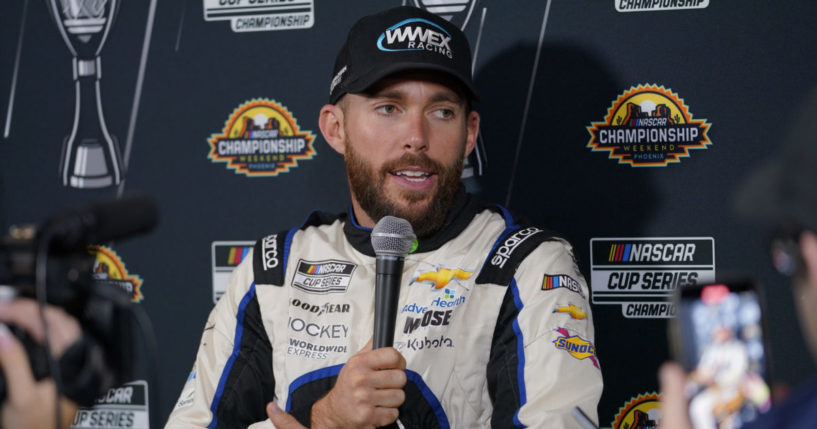
NASCAR Bans Controversial Move That Helped Ross Chastain Win 2022 Martinsville Cup
NASCAR has essentially banned the “Hail Melon” video-game move driver Ross Chastain used at Martinsville Speedway to race his way into the championship finale.
Chastain last year mashed the gas and deliberately smashed into the wall so that the energy would speed his car past his rivals.
The move advanced him into NASCAR’s title-deciding final race on the final of the four spots, and was lauded by motorsports figures globally.
But his fellow NASCAR competitors thought Chastain’s trick was both dangerous and not in the spirit of fair competition.
NASCAR on Tuesday said the wall-hugging, jaw-dropping pass Chastain made on the final lap will be a penalty in 2023.
“Not a new rule,” said Elton Sawyer, NASCAR’s vice president of competition. “I think we all remember the last-lap move at Martinsville in the fall. Brought a great deal of excitement, a great deal of exposure to our sport.
“But it also came with some scrutiny.”
NASCAR cited rule 10.5.2.6.A, which states “any violations deemed to compromise the safety of an event or otherwise pose a dangerous risk to the safety of competitors, officials, spectators or others are treated with the highest degree of seriousness.”
Sawyer said there was internal discussion about needing to “do something,” but NASCAR waited until after the season to collaborate, study data and dig into the rulebook.
“This is not new language,” he said. “Basically if there’s an act that we feel that’s compromising the safety of our competitors, officials, spectators, we’re going to take that seriously. That move at Martinsville would be a penalty in 2023.”
Chastain was on the verge of playoff elimination when he harkened to a racing move he used on GameCube with his brother, Chad, as a kid. He plastered his car against the outside wall, let go of the steering wheel and pushed the pedal to the floor.
It worked just like it did in the video game.
Suddenly, on the final half-lap at the Martinsville short track, Chastain’s car looked as if it was turned up to hyper-speed while everyone else was poking along.
Going at least 50 mph faster than everyone else, he passed five cars in a matter of seconds to claim the final spot in the title race.
He finished second to Joey Logano in the championship finale in Phoenix.
Other notable changes for NASCAR’s Cup Series in 2023:
— Losing a wheel will no longer be a four-race suspension to the crew chief and two crew members. It will be a two-race suspension for two crew members if it happens beyond pit road.
— There will no longer be stage breaks at road courses. NASCAR will still award points at the end of stages, only without the artificial caution.
— NASCAR will give teams seven minutes on pit road to work on their cars if they are damaged in an accident. It was six minutes last year before being increased to 10 minutes for the Cup playoffs.
— Restart zones will be increased by 50% — 25% more room before the start/finish line and 25% more at the end. The rule change goes into effect for the first five events of the season and will be reevaluated from there.
— NASCAR removed the top-30-in-points requirement for drivers trying to make the playoffs. Drivers will still be required to participate in every event unless granted a waiver (typically for an injury).
— Mufflers will be used in the season-opening Clash, an exhibition race that will take place at the Los Angeles Coliseum for the season straight year. Mufflers will reduce engine noise and create an atmosphere better suited for fan conversations.
— NASCAR tweaked language in its rulebook to mandate fire-retardant underclothing from the neck to the wrists to the ankles. It had previously been recommended.
— NASCAR will use new recording systems in cars that will provide more powerful crash data. It’s a significant upgrade from the black box technology first used in 2002 following Dale Earnhardt’s death at Daytona International Speedway.
— NASCAR will have a “large increase” in the number of drivers who will wear mouth-piece sensors at races. They were not available at every event in 2022 but will be beginning in 2023. Data recorders measure what cars experience; this would provide data directly from drivers and what they go through during races, specifically in crashes.
— NASCAR officially designated eight locations at which wet-weather packages (rain tires) will be available in 2023: the LA Coliseum (the Clash), Lucas Oil Raceway in Indianapolis, Martinsville, Milwaukee, New Hampshire, North Wilkesboro (All-Star race), Phoenix and Richmond. NASCAR will have “rain” tires and teams will be required to have windshield wiper hookups and rear lights in case NASCAR wants to race in damp conditions for the Clash, Martinsville, New Hampshire, North Wilkesboro, Phoenix and Richmond.
The Western Journal has reviewed this Associated Press story and may have altered it prior to publication to ensure that it meets our editorial standards.
Truth and Accuracy
We are committed to truth and accuracy in all of our journalism. Read our editorial standards.
Advertise with The Western Journal and reach millions of highly engaged readers, while supporting our work. Advertise Today.












